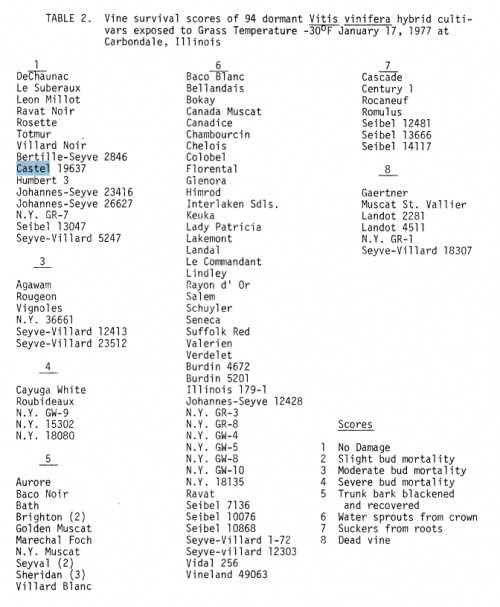To wino z Castela znalazłem tylko w Szwajcarii, w interesującym zestawie:
http://bloomhandelsag.ch/produkt/weinpaket-nova-scotia-kanada/Niestety odpisali że nie wysyłają do EU z powodu formalności celnych.
Trzeba więc będzie poczekać na własne. Będę go szczepił na podkładkach bo u mnie zbyt wysokie pH i pewnie by łapał chlorozę.
Spróbuje też zaszczepić go na starym krzewie i jak się przyjmie to może jakieś kontrolne grono byłoby już w tym sezonie.
A tu potwierdzenie wysokiej mrozoodporności Castela (-28.8C w powietrzu / -34.4C przy gruncie) :

-- So lut 17, 2018 7:34 pm --
I jeszcze ciekawy opis tej odmiany ze strony:
http://www.readbag.com/aberfoyle-castel-articleprhCytuj:
Castel 19637, an Obscure Variety that Deserves More Consideration By Peter Hemstad, U of M Viticulturist Castel 19637 is a variety that should be considered by northern growers looking for an early ripening red with reasonable cold hardiness and an intriguing flavor. Pierre Galet, in his `Cepages et Vignobles de France' gives a brief description of the variety which I'll roughly translate as: "This is a small producer, subject to spring frost, with a very early bud break, giving a very colored wine, 3 times more colored than Cabernet Sauvignon, with an herbaceous aroma, very alcoholic, 14.6° at Montpelier. The wine is used in blending and for the preparation of `mistelles' [a sweet beverage used as a base for aperitifs] in the Loire Valley. The leaves have some resistance to phylloxera galls; the resistance to downy mildew is rather feeble and it must be sprayed... but it has a practical resistance to powdery mildew." Galet also lists the parentage as (Cinsaut X V. rupestris) and says there were about 150 acres of Castel 19637 planted in Burgundy and the Loire Valley, although he's unclear about the year. More recently, Castel 19637 has been grown on a small scale in Nova Scotia, Scandinavia, Belgium, and England. In the words of one English nursery catalog (Sunnybank Vine Nurseries in Herefordshire) Castel "ripens well here, disease free, big crop, good sugars, promising." Of course, nursery catalogs have been known to occasionally exaggerate a bit! At the University of Minnesota's H.R.C. we've been growing Castel 19637 since the mid 1980's. Over the last 20 years it has done quite well except after extreme winters. Since extreme winters seem to be happening less and less often these days, Castel has performed well the last few years. Yields have been good recently, averaging 12.5 lbs/vine in 2005 and 20.7 lbs/vine in 2006, over 6 tons/acre. Castel is definitely early ripening, a few days before Foch and well before Frontenac. This would obviously be an advantage in very cool climates. On the other hand, like most early ripening black grapes, Castel is quite attractive to birds and may require netting. The harvest parameters have been very good, averaging 23.9° brix, 3.05 pH, and 10.3 g/l of acidity. By Minnesota standards, those are excellent numbers. Based on our experience, early bud break would be a concern for growers on poor sites in Minnesota or anywhere further south where spring frost is a major issue (Nebraska, Iowa, Illinois, etc.). At the H.R.C. our test vineyards are on high ground and Castel has rarely been hurt by spring frost. It seems fairly resistant to foliar phylloxera and moderately resistant to powdery and downy mildew. Black Rot is a relatively uncommon disease in our vineyards, but we have occasionally seen a small amount on Castel 19637. Again, that could be more of a problem further south. Perhaps the most compelling reason to consider planting this variety is its unusual flavor. As the grapes near maturity, Castel develops a strong cedar cigar-box flavor that I find quite appealing. This character also comes through in the resulting wines. While possibly too intense as a varietal, cedar and tobacco aromas are certainly very desirable in a big red wine and Castel may prove to be a very useful blending component for creative winemakers. While I don't expect Castel 19637 to revolutionize northern grape growing, I do think that based on its unique flavors, early ripening, and overall vineyard performance it is worthy of trial in northern areas where summers are short and winters aren't too extreme. (Northern Michigan, Door County and northern Wisconsin along Lake Superior, New England, and Quebec all seem like places where this variety might be worth a try.)



